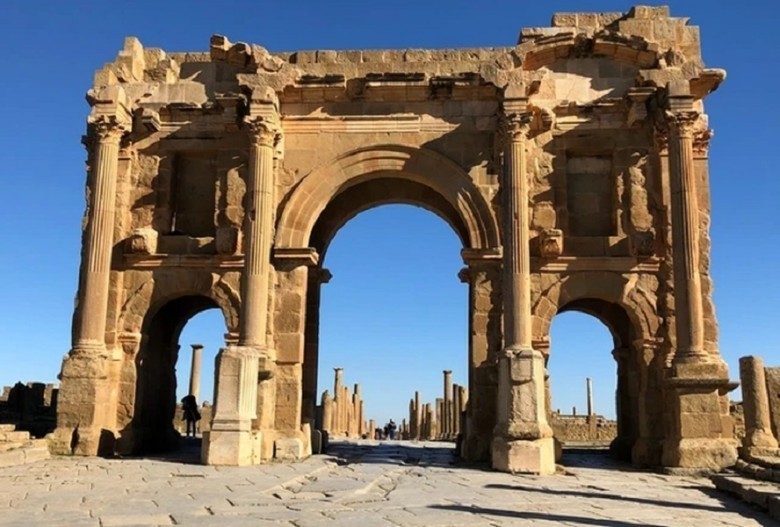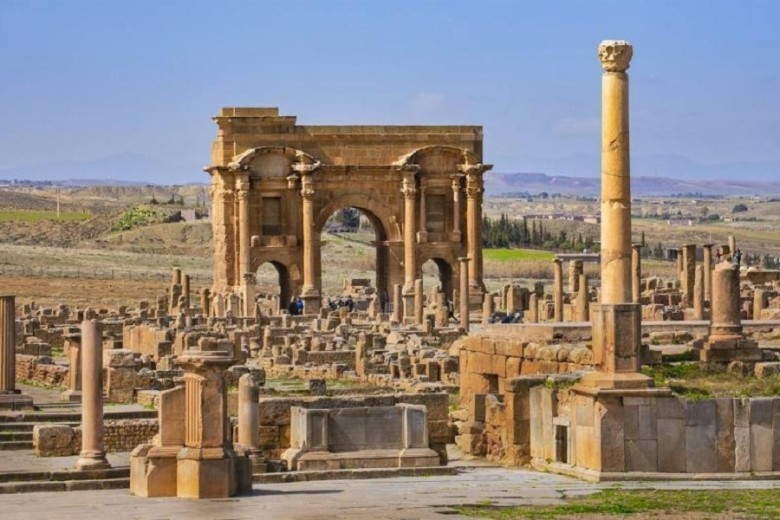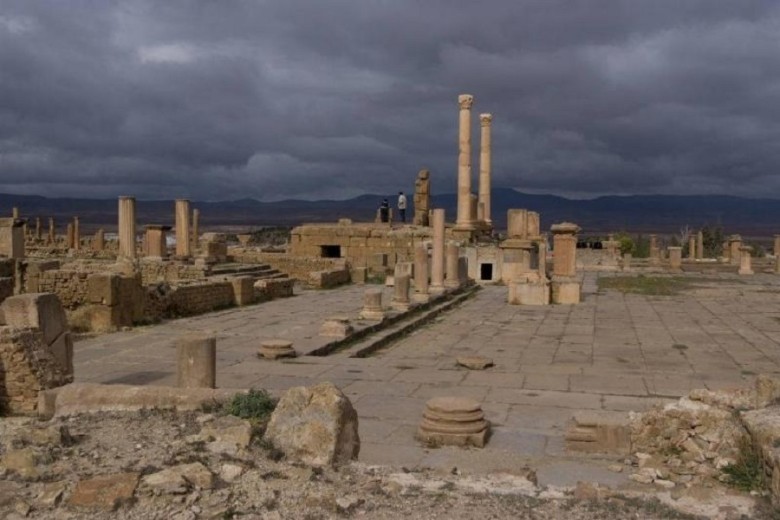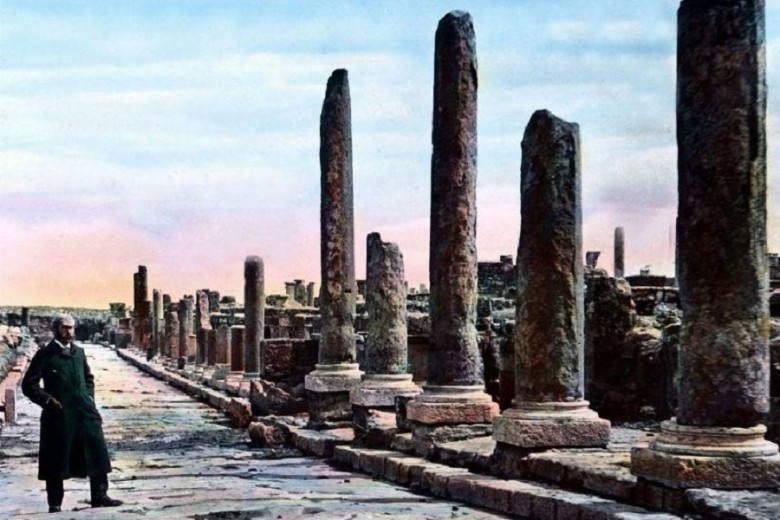
views
Timgad - the Forgotten City in the Heart of the Sahara
Welcome to the mysterious city of Timgad, a city of the former Roman Empire in the heart of the Sahara. Abandoned by its Roman inhabitants, it was forgotten for a thousand years. Today, we finally know its secret.

For nearly three centuries, archaeologists from all over the world worked to uncover the secrets of Timgad. A city that had been swallowed by the desert and preserved by eternal sand.
Built for Protection
The city of Timgad was founded by the Roman Empire at the height of its power. The Romans decided to build it on the sides of the Aures Mountains in present-day Algeria.

The purpose of the city was to serve as a protection for the empire's highly valuable trade routes against the tribes in the south. Timgad fulfilled this vital purpose for several centuries. The routes were secure.
Home to Thousands of Romans
Although Timgad was built far from the heart of the Roman Empire, it had no shortage of citizens and was referred to as home by thousands of Romans. Impressive is the fact that Timgad's public buildings were described by experts as being on par in terms of level and complexity with those in Pompeii.

Timgad also housed the Third Augustan Legion, making it an impressive city. Hence, it is understandable that it remained a thriving establishment so far south.
A Scottish Explorer
When analyzing the ruins, one can easily imagine that Timgad was most likely one of the most generous outposts of the empire. However, for some reason, it was completely abandoned in the 8th century AD.

For the next 1,000 years, the once great city would become ruins and eventually merge with the sand of the Sahara. There it remained until the 18th century when a Scottish explorer stumbled upon the ruins. This is where the story of the city begins.
Built by Roman Emperor Trajan
It was the Roman Emperor Trajan who built the city, known then as Thamugadi or Tamugas. In 100 AD, the Roman Empire was so vast and powerful that it made Trajan one of the most powerful men in the world.

Under his rule, which lasted for 19 years, Rome expanded exponentially, covering over three million square kilometers of land. In this entire land, Rome at its height had an estimated population of around 65 million people.
Timgad was built in the shadow of the Aurès Mountains
During Trajan's time, the Roman Empire extended from Britain to present-day Egypt. Scattered throughout were numerous cities, many of which were more impressive than most people know.

When it came to the founding of Timgad, Trajan wanted to build it from scratch in the shadow of the Aurès Mountains. Trajan knew how important it was to protect the trade routes in North Africa, which were crucial for the circulation of grain throughout the empire.
City Planning
Before the first stone was laid, Trajan and the city planners put a lot of thought into how the city should be built. Modern experts were more than impressed when the city was first discovered, mainly because of the grid system in which it was laid out.

It had the shape of a square and was divided by two main streets, one running from north to south and the other from east to west. Where the two streets met, a forum was constructed.
Amenities
Although Timgad is located in the middle of an African desert, it had no shortage of amenities for its citizens. Just to name a few, the city included a huge library, a theater, a basilica, and dozens of bathhouses.

Furthermore, in addition to its magnificent architecture, the city was also covered in beautiful mosaics, which are considered some of the finest in the empire. To top it all off, a massive arch was built, dedicated to Emperor Trajan.
Trajan ensured the city was protected
To protect the southern border of the empire from its enemies, Trajan knew that he needed to deploy an army in the area so far from Rome. So he stationed the Third Augustan Legion there.

Every two years, Trajan would retire around 200 soldiers from service and grant them land in and around Timgad. This turned Timgad into a popular home for retired soldiers who could defend against attackers when needed.
It bloomed and withered
Timgad was a thriving and diverse city for a long time, shared by both Christians and followers of older religions. However, during this time, something happened that caused the metropolis to crumble.

By the 8th century, it was nothing more than piles of stones as the surrounding desert sand slowly consumed it. There it remained lost, except for a handful of locals, until a curious Scottish adventurer arrived in the area.
James Bruce
In 1763, Scottish adventurer James Bruce arrived in North Africa. There, he was appointed as the consul in Algiers, the present-day capital of Algeria. Though suitable for the job, he clashed with his superiors due to his ambition and intelligence.

This led to his dismissal from the position in 1765. However, Bruce had no intention of returning home and embarked on a journey through Africa accompanied by Italian artist Luigi Balugani.
Searching for Lost Civilizations
As it turned out, Bruce and Balugani did indeed have intentions to find the remains of an ancient civilization during their trek through the desert of southern Algeria. On December 12, 1765, they stumbled upon something incredible.

On the side of the Aurès Mountains, they found themselves amidst the ruins of Timgad. The city was partially buried by desert sand, but the two explorers could still discern that they had found something spectacular.
Untouched for Centuries
As the two explorers entered the ancient city of Timgad, they were the first Europeans to walk through the abandoned and largely sand-infested city in centuries.

In his private diary about the city, Bruce wrote, "It was a small city, but full of elegant buildings." It also didn't take long for the two men to find the Trajan's arch, standing about twenty meters tall.
More Surprises
After wandering through the ruins, it is not surprising that the two men also came across the massive amphitheater, which is hard to miss. They also recognized some of the statues of famous Romans scattered throughout the city.

According to the two researchers and explorers, Bruce and Balugani, one of the statues was a likeness of Antonius Pius, a Roman emperor of the 2nd century AD. Another was of Pius' wife, Faustina the Elder.
Few people believed him
Instead of returning home to report what he had found, Bruce did the opposite. He buried all the artifacts they had found, and the men continued their journey through Africa.

When they reached Ethiopia, they even claimed to have found the source of the Blue Nile, although this is disputed among scholars. When he finally returned home in 1774, his report of his discoveries in Africa was met with skepticism by many.
Rediscovered in 1875
Then, in 1875, it was announced that a British diplomat had discovered the lost city of Timgad. This was done by Robert Lambert Playfair, who ironically also served as consul in Algiers. He too embarked on a great journey through Africa and discovered what Bruce had spoken of.

However, Playfair did not walk away from his discovery, but instead began to research and excavate the site to establish new connections about the city, so he could understand what had happened.
Groundbreaking Observations
In the initial analysis of the city, Playfair proclaimed that Timgad was exactly where six main roads converged. He also noted that he believed the city's architecture surpassed many Roman cities, even Lambaesis, a neighboring capital.

All in all, he concluded that the city served an important purpose and should not be ignored as in the past. He knew there was much to learn here.
The Ancient Ruins
At the time of Playfair's rediscovery, Algeria had fallen under French control, and French colonizers began to settle around the city.

Then, in 1881, Europeans managed to take control of the area where Timgad is located in the mountains. From then on, and for the next eight decades until the Algerian War of Independence, the ancient ruins of Timgad remained in the hands of a foreign power.
The French conducted research
While under French possession, researchers and experts quickly began excavating and studying the ruins of the city. It didn't take long for them to realize they had found something incredible.

Unlike most discovered ancient Roman cities, this one was not tainted by the modernization of a city like Rome itself. Timgad had remained mostly untouched and preserved by desert sand.
The French made several findings
Thanks to Playfair and the excavation by French researchers, the world would now learn the history behind the lost city of Timgad. The French concluded that Trajan had made the city a place of prosperity.

Researchers quickly realized it was not a randomly established outpost in the middle of the African desert. It was also discovered that many of the structures found had been added and restored over the years of the city's existence.
Life in Timgad
From their findings, researchers speculated that life for the average citizen in Timgad was likely better than in most other parts of the empire, in addition to all the extravagant public areas.

There were more than 14 bathhouses throughout the city, and apparently private homes adorned with intricate mosaics and other luxuries. Interestingly, in the 3rd century, Timgad became a popular place for Christians before becoming the site of the Donatist sect.
The Empire faced challenging times
Unfortunately, the Roman Empire had some serious problems of its own during this time. Since the 2nd century AD, the Germanic tribes, also known as Vandals, had been devastating Rome's borders and constantly exerting violence.

In the 4th century, the Vandals were no longer Rome's only concern. They also had to deal with threats from the Huns and the Goths. The Roman Empire was feeling the pressure.
Roman cities began to fall
After 370 AD, things were looking grim for the Roman Empire. From then on, the Huns slowly infiltrated the Vandals' territory, who in turn pushed into the Roman Empire.

The Germanic tribes then began to invade the Roman territory and conquer the isolated cities they found along their way. This began with the region known as Gaul, before making their way to present-day Spain and soon after to North Africa, where Timgad was located.
Timgad was lost
Tragically, by the 5th century, the Vandals had become such a powerful force in the Roman territories that they managed to penetrate the southernmost region of Rome. It was during this time that they lost Timgad.

While the loss of Timgad was devastating for the Romans, it was their least concern at this point. When Timgad fell to the Germanic tribes, Rome began to truly feel their losses. The entire empire began to crumble.
The Decline
After the fall of Timgad, the Vandals essentially became an unstoppable force, setting their sights on the city of Rome itself. The Vandals eventually reached their goal in 455 AD.

They plundered Rome, leaving most of the historical buildings intact. The Vandals then controlled a significant portion of the Roman Empire, including their territories in North Africa, which included Timgad.
Rome attempts to fight back
Despite the losses to the Vandals, Rome would not give up easily. Slowly, they began to subdue the Germanic tribes, hoping to rebuild their once seemingly unstoppable empire.

Timgad remained weak, too far from the empire to provide assistance. However, in 533 AD, the Roman Empire entered the Vandalic War, reclaiming their territories in North Africa. But when General Solomon arrived in Timgad, he found the city abandoned.
Rebuilding what was lost
Rome wanted to rebuild Timgad to what it once was. They began constructing a new fortress on the outskirts of the city. However, being in such a remote location, it was completely dependent on Rome for survival.

When the Arabs began to invade the southern regions of Rome in the 7th century, it quickly became apparent that Rome was unable to adequately support its troops far from the capital.
Abandoned forever
In the 8th century, the once-great city of Timgad was finally abandoned. After everyone departed, the sands of the Sahara reclaimed the city. Soon, its spectacular architecture and bustling public squares were covered in sand.

It remained buried under the sand until it was rediscovered by European explorers. At that point, it was already buried under a whole meter of earth. So, we can consider ourselves fortunate that this city is accessible to us again today.
The sand was their salvation
The fact that the Sahara sand nearly covered the vast city had an advantage. Incredibly, the sand actually helped preserve a large part of the architecture and artwork that would have otherwise been lost over the course of millennia.

This allowed for extensive study. For the first time in history, modern society gained a clear insight into the appearance of the southern reaches of the Roman Empire.
Particularly remarkable
While Timgad may have been lost to history for some time, it has become a place of learning for many. Approximately 20 years after Algeria gained independence from the French and excavation of the city ceased, the ancient city was named a UNESCO World Heritage Site.

Today, the city is being examined by historians, architects, and other researchers, mainly because it provides a detailed example of the intricacies of Roman city planning and its capabilities.
A popular tourist attraction
Since the city has been completely uncovered since its initial discovery, it seemed a shame to keep Timgad hidden from people. As a result, it has become a popular tourist attraction in recent years, and one of the hotspots that can be visited on numerous tours of Algeria.

While many visitors marvel at the wonders left behind, such as the Arch of Trajan, few know how magnificent it once was and what actually led to its downfall. Surely, there is much more to discover... only time will tell.




















Comments
0 comment